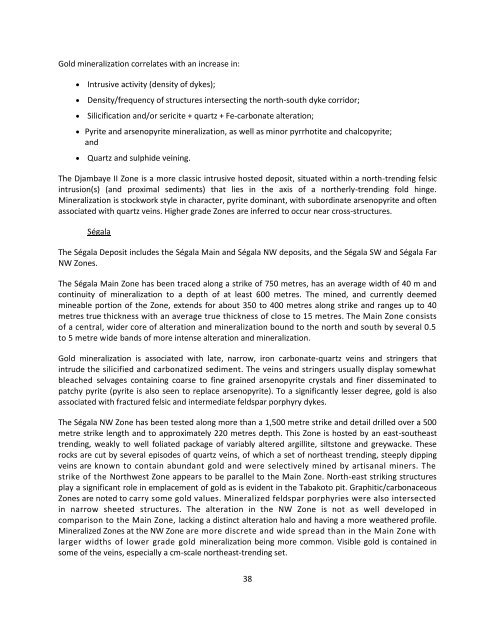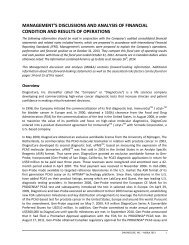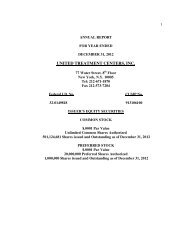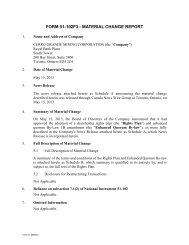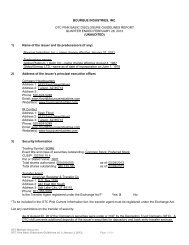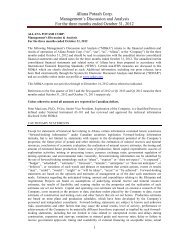ANNUAL INFORMATION FORM ENDEAVOUR MINING CORPORATION
ANNUAL INFORMATION FORM ENDEAVOUR MINING CORPORATION
ANNUAL INFORMATION FORM ENDEAVOUR MINING CORPORATION
You also want an ePaper? Increase the reach of your titles
YUMPU automatically turns print PDFs into web optimized ePapers that Google loves.
Gold mineralization correlates with an increase in:<br />
Intrusive activity (density of dykes);<br />
Density/frequency of structures intersecting the north-south dyke corridor;<br />
Silicification and/or sericite + quartz + Fe-carbonate alteration;<br />
Pyrite and arsenopyrite mineralization, as well as minor pyrrhotite and chalcopyrite;<br />
and<br />
Quartz and sulphide veining.<br />
The Djambaye II Zone is a more classic intrusive hosted deposit, situated within a north-trending felsic<br />
intrusion(s) (and proximal sediments) that lies in the axis of a northerly-trending fold hinge.<br />
Mineralization is stockwork style in character, pyrite dominant, with subordinate arsenopyrite and often<br />
associated with quartz veins. Higher grade Zones are inferred to occur near cross-structures.<br />
Ségala<br />
The Ségala Deposit includes the Ségala Main and Ségala NW deposits, and the Ségala SW and Ségala Far<br />
NW Zones.<br />
The Ségala Main Zone has been traced along a strike of 750 metres, has an average width of 40 m and<br />
continuity of mineralization to a depth of at least 600 metres. The mined, and currently deemed<br />
mineable portion of the Zone, extends for about 350 to 400 metres along strike and ranges up to 40<br />
metres true thickness with an average true thickness of close to 15 metres. The Main Zone consists<br />
of a central, wider core of alteration and mineralization bound to the north and south by several 0.5<br />
to 5 metre wide bands of more intense alteration and mineralization.<br />
Gold mineralization is associated with late, narrow, iron carbonate-quartz veins and stringers that<br />
intrude the silicified and carbonatized sediment. The veins and stringers usually display somewhat<br />
bleached selvages containing coarse to fine grained arsenopyrite crystals and finer disseminated to<br />
patchy pyrite (pyrite is also seen to replace arsenopyrite). To a significantly lesser degree, gold is also<br />
associated with fractured felsic and intermediate feldspar porphyry dykes.<br />
The Ségala NW Zone has been tested along more than a 1,500 metre strike and detail drilled over a 500<br />
metre strike length and to approximately 220 metres depth. This Zone is hosted by an east-southeast<br />
trending, weakly to well foliated package of variably altered argillite, siltstone and greywacke. These<br />
rocks are cut by several episodes of quartz veins, of which a set of northeast trending, steeply dipping<br />
veins are known to contain abundant gold and were selectively mined by artisanal miners. The<br />
strike of the Northwest Zone appears to be parallel to the Main Zone. North-east striking structures<br />
play a significant role in emplacement of gold as is evident in the Tabakoto pit. Graphitic/carbonaceous<br />
Zones are noted to carry some gold values. Mineralized feldspar porphyries were also intersected<br />
in narrow sheeted structures. The alteration in the NW Zone is not as well developed in<br />
comparison to the Main Zone, lacking a distinct alteration halo and having a more weathered profile.<br />
Mineralized Zones at the NW Zone are more discrete and wide spread than in the Main Zone with<br />
larger widths of lower grade gold mineralization being more common. Visible gold is contained in<br />
some of the veins, especially a cm-scale northeast-trending set.<br />
38


